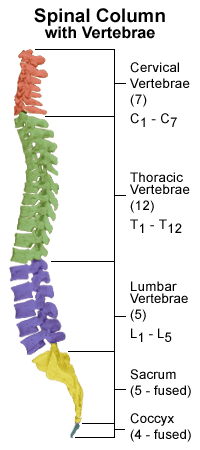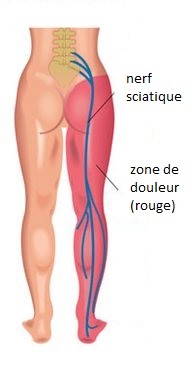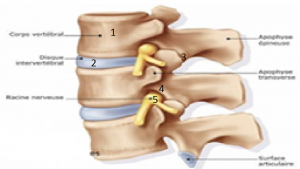
Everything you need to know about lumbar (lower back) pain
Lumbar (or lower back) pain is a very common condition. Up to 85% of the population experiences it at some time in their lives. Of this high percentage, the majority will recover within the first three months. However, nearly half will have a recurrence.
Anatomy and terminology
To fully understand the conditions and injuries that affect the lumbar spine, it is important to understand its anatomy.

-
The lumbar spine is made up of five vertebrae.
-
Each vertebra has a rigid part at the front (the vertebral body, identified by the number 1 in the picture below) and a hole in the centre through which the spinal cord passes.
-
Each vertebral body is separated by a disc (number 2).
-
At the centre of the disc is a semi-liquid, gel-like nucleus that is surrounded by a fibrous ring (annulus fibrosus).
-
Each vertebra is connected by a set of joints called the facet joints (number 3), which are located on either side of the spine.
-
The spinal canal (number 4) is located between and on either side of each vertebra. It is a small passage through which the spinal nerve (number 5) runs freely.
-
The sciatic nerve is a combination of several spinal nerves. It emerges from the lumbar region and extends down to the feet.
The nerves that emerge from the lumbar region innervate the lower limbs. Our ability to move and feel our legs depends on the proper functioning of these nerves. It is therefore important that the spinal canal remain free and clear, because any irritation or compression of the spinal nerve could upset this mechanism and result in numbness, decreased sensitivity, and weakness. Lastly, all the structures listed above (muscles, ligaments, joints) can be a source of pain. Lower back pain is often triggered by an injury to one or more of these structures.
Causes of lumbar pain
According to the literature on lumbar spine pathologies, the cause of lumbar pain is multifactorial. In fact, the causes vary depending on the individual, their pain history, their level of physical activity, the nature of their job, etc. Other factors such as poor posture at work or during daily activities, prolonged sitting, and improper lifting (usually while bending or rotating) can weaken the lumbar spine over the long term. It is important to be aware of these factors. After all, prevention is the best cure.
Lumbar pathologies
There are many pathologies that can affect the lumbar region. In fact, the lower back is susceptible to several injuries, both traumatic and degenerative. The list below is not exhaustive, but it can help you understand the most common lumbar pathologies.
Weakening of the annulus fibrosus can lead to a herniated disc if the softer part of the disc (the gel-like nucleus) leaks out of its usual position. Once the nucleus is out, it can cause pain, numbness and/or muscle weakness by irritating or compressing nerve roots. It could also cause lumbosciatica.
Lumbosciatica is pain that travels down the leg along the path of the sciatic nerve with or without lumbar pain.

Lumbar facet irritation is the irritation of the joints on either side of the lumbar spine. It can be caused in part by poor posture (e.g., increased curvature of the lower back) or by poor work positions. Usually, the pain will be rather local and is rarely felt in the leg.

Other conditions of the lumbar spine include spondylolisthesis, spinal stenosis, and foraminal stenosis, to name a few. Lastly, chronic lumbar pain (pain lasting more than 3-6 months) is quite different from acute (short-term pain) and subacute (pain lasting less than 3 months) lumbar pain. Their treatments are also very different.
In a nutshell, the lumbar region is relatively complex, which is why it’s important to take good care of it and to consult a physiotherapist, who will properly identify your condition and its components in order to prescribe the right treatment.
Article written by Alexis Lasalle, physiotherapist
Need to talk to a professional?
Other articles that might interest you...

Tennis: Protect your Shoulders and Prevent Injuries
In collaboration with Tennis Québec. Tennis is a very popular sport, especially in summer when it...

Running Warm-Up: Why and How to Prepare Properly Outdoors
This article was written in collaboration with The 6AM Club. A proper warm-up and cooldown are...

Construction Workers: Prevention Is Better Than Cure
The construction industry includes a wide variety of trades, many of which involve demanding...
 Home
Home
